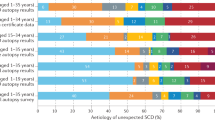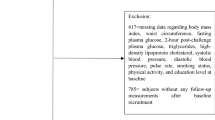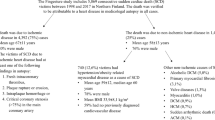Abstract
Sudden cardiac death (SCD) is a global health issue. The unexpected nature of this devastating condition compounds the urgency of discovering methods for early detection of risk, which will lead to more effective prevention. However, the complex and dynamic nature of SCD continues to present a considerable challenge for the early identification of risk factors. Measurement of the left ventricular ejection fraction (LVEF) is currently the only major risk factor used for stratification in clinical practice. Severely decreased LVEF is likely to manifest late in the natural history of SCD, however, and may only affect a small subgroup of patients who will suffer SCD. A growing body of literature describes novel risk markers and predictors of SCD, such as high-risk phenotypes, genetic variants and biomarkers. This Review will discuss the potential utility of these markers as early identifiers of risk, and suggests a framework for the conduct of future studies for the discovery, validation, and deployment of novel SCD risk factors.
Key Points
-
Sudden cardiac death (SCD) results in 200,000–250,000 deaths in the US every year
-
The left ventricular ejection fraction is currently the only clinical variable used for SCD risk stratification
-
Few risk factors are available owing to the complexity of SCD and its asymptomatic nature; further research is needed to find novel markers that can identify high-risk individuals
-
Phenotypes associated with SCD include left ventricular hypertrophy, prolonged QTc interval, and increased resting heart rate; a genetic susceptibility for SCD also exists
-
Novel risk markers of SCD identified in the blood and from molecular imaging techniques will be used for SCD risk stratification in the future
-
A risk score for early prediction of SCD that consists of a panel of markers will be more effective than any individual marker
This is a preview of subscription content, access via your institution
Access options
Subscribe to this journal
Receive 12 print issues and online access
$209.00 per year
only $17.42 per issue
Buy this article
- Purchase on Springer Link
- Instant access to full article PDF
Prices may be subject to local taxes which are calculated during checkout







Similar content being viewed by others
References
Chugh, S. S. et al. Epidemiology of sudden cardiac death: clinical and research implications. Prog. Cardiovasc. Dis. 51, 213–228 (2008).
Nichol, G. et al. Regional variation in out-of-hospital cardiac arrest incidence and outcome. JAMA 300, 1423–1431 (2008).
Chugh, S. S. et al. Current burden of sudden cardiac death: multiple source surveillance versus retrospective death certificate-based review in a large U.S. community. J. Am. Coll. Cardiol. 44, 1268–1275 (2004).
Zipes, D. P. & Wellens, H. J. Sudden cardiac death. Circulation 98, 2334–2351 (1998).
Huikuri, H.V., Castellanos, A. & Myerburg, R. J. Sudden death due to cardiac arrhythmias. N. Engl. J. Med. 345, 1473–1482 (2001).
Goldenberg, I., Zareba, W. & Moss, A. J. Long QT Syndrome. Curr. Probl. Cardiol. 33, 629–694 (2008).
Maron, B. J. Contemporary insights and strategies for risk stratification and prevention of sudden death in hypertrophic cardiomyopathy. Circulation 121, 445–456 (2010).
Bardy, G. H. et al. Amiodarone or an implantable cardioverter-defibrillator for congestive heart failure. N. Engl. J. Med. 352, 225–237 (2005).
Moss, A. J. et al. Prophylactic implantation of a defibrillator in patients with myocardial infarction and reduced ejection fraction. N. Engl. J. Med. 346, 877–883 (2002).
Myerburg, R. J., Mitrani, R., Interian, A., Jr & Castellanos, A. Interpretation of outcomes of antiarrhythmic clinical trials: design features and population impact. Circulation 97, 1514–1521 (1998).
de Vreede-Swagemakers, J. J. et al. Out-of-hospital cardiac arrest in the 1990s: a population-based study in the Maastricht area on incidence, characteristics and survival. J. Am. Coll. Cardiol. 30, 1500–1505 (1997).
Gorgels, A. P., Gijsbers, C., de Vreede-Swagemakers, J., Lousberg, A. & Wellens, H. J. Out-of-hospital cardiac arrest—the relevance of heart failure. The Maastricht Circulatory Arrest Registry. Eur. Heart J. 24, 1204–1209 (2003).
Stecker, E. C. et al. Population-based analysis of sudden cardiac death with and without left ventricular systolic dysfunction: two-year findings from the Oregon Sudden Unexpected Death Study. J. Am. Coll. Cardiol. 47, 1161–1166 (2006).
Goldberger, J. J. et al. American Heart Association/American College of Cardiology Foundation/Heart Rhythm Society scientific statement on noninvasive risk stratification techniques for identifying patients at risk for sudden cardiac death: a scientific statement from the American Heart Association Council on Clinical Cardiology Committee on Electrocardiography and Arrhythmias and Council on Epidemiology and Prevention. Circulation 118, 1497–1518 (2008).
Camm, A. J. et al. Mortality in patients after a recent myocardial infarction: a randomized, placebo-controlled trial of azimilide using heart rate variability for risk stratification. Circulation 109, 990–996 (2004).
La Rovere, M. T. et al. Baroreflex sensitivity and heart rate variability in the identification of patients at risk for life-threatening arrhythmias: implications for clinical trials. Circulation 103, 2072–2077 (2001).
Galinier, M. et al. Prognostic value of late potentials in patients with congestive heart failure. Eur. Heart J. 17, 264–271 (1996).
Silverman, M. E. et al. Prognostic value of the signal-averaged electrocardiogram and a prolonged QRS in ischemic and nonischemic cardiomyopathy. Am. J. Cardiol. 75, 460–464 (1995).
Costantini, O. et al. The ABCD (Alternans Before Cardioverter Defibrillator) Trial: strategies using T-wave alternans to improve efficiency of sudden cardiac death prevention. J. Am. Coll. Cardiol. 53, 471–479 (2009).
Gold, M. R. et al. Role of microvolt T-wave alternans in assessment of arrhythmia vulnerability among patients with heart failure and systolic dysfunction: primary results from the T-wave alternans sudden cardiac death in heart failure trial substudy. Circulation 118, 2022–2028 (2008).
Rosenbaum, D. S. et al. Electrical alternans and vulnerability to ventricular arrhythmias. N. Engl. J. Med. 330, 235–241 (1994).
Haider, A. W., Larson, M. G., Benjamin, E. J. & Levy, D. Increased left ventricular mass and hypertrophy are associated with increased risk for sudden death. J. Am. Coll. Cardiol. 32, 1454–1459 (1998).
Straus, S. M. et al. Prolonged QTc interval and risk of sudden cardiac death in a population of older adults. J. Am. Coll. Cardiol. 47, 362–367 (2006).
Callans, D. J., Menz, V., Schwartzman, D., Gottlieb, C. D. & Marchlinski, F. E. Repetitive monomorphic tachycardia from the left ventricular outflow tract: electrocardiographic patterns consistent with a left ventricular site of origin. J. Am. Coll. Cardiol. 29, 1023–1027 (1997).
Chugh, S. S. et al. Population-based analysis of sudden death in children: The Oregon Sudden Unexpected Death Study. Heart Rhythm 6, 1618–1622 (2009).
Chugh, S. S. et al. Determinants of prolonged QT interval and their contribution to sudden death risk in coronary artery disease: the Oregon Sudden Unexpected Death Study. Circulation 119, 663–670 (2009).
Chugh, S. S. et al. A community-based evaluation of sudden death associated with therapeutic levels of methadone. Am. J. Med. 121, 66–71 (2008).
Chugh, S. S. et al. Women have a lower prevalence of structural heart disease as a precursor to sudden cardiac arrest: The Ore-SUDS (Oregon Sudden Unexpected Death Study). J. Am. Coll. Cardiol. 54, 2006–2011 (2009).
Reddy, P. R. et al. Physical activity as a trigger of sudden cardiac arrest: the Oregon Sudden Unexpected Death Study. Int. J. Cardiol. 131, 345–349 (2009).
Reinier, K. et al. Incidence of sudden cardiac arrest is higher in areas of low socioeconomic status: a prospective two year study in a large United States community. Resuscitation 70, 186–192 (2006).
Stecker, E. C. et al. Allelic variants of SCN5A and risk of sudden cardiac arrest in patients with coronary artery disease. Heart Rhythm 3, 697–700 (2006).
Lemmert, M. E. et al. Electrocardiographic factors playing a role in ischemic ventricular fibrillation in ST elevation myocardial infarction are related to the culprit artery. Heart Rhythm 5, 71–78 (2008).
Das, M. K. & Zipes, D. P. Fragmented QRS: a predictor of mortality and sudden cardiac death. Heart Rhythm 6, S8–S14 (2009).
Dyer, A. R. et al. Heart rate as a prognostic factor for coronary heart disease and mortality: findings in three Chicago epidemiologic studies. Am. J. Epidemiol. 112, 736–749 (1980).
Jouven, X., Zureik, M., Desnos, M., Guérot, C. & Ducimetière, P. Resting heart rate as a predictive risk factor for sudden death in middle-aged men. Cardiovasc. Res. 50, 373–378 (2001).
Kannel, W. B., Kannel, C., Paffenbarger, R. S., Jr & Cupples, L. A. Heart rate and cardiovascular mortality: the Framingham Study. Am. Heart J. 113, 1489–1494 (1987).
Shaper, A. G., Wannamethee, G., Macfarlane, P. W. & Walker, M. Heart rate, ischaemic heart disease, and sudden cardiac death in middle-aged British men. Br. Heart J. 70, 49–55 (1993).
Jouven, X. et al. Excessive heart rate increase during mild mental stress in preparation for exercise predicts sudden death in the general population. Eur. Heart J. 30, 1703–1710 (2009).
Albert, C. M. et al. Prospective study of sudden cardiac death among women in the United States. Circulation 107, 2096–2101 (2003).
Balkau, B., Jouven, X., Ducimetière, P. & Eschwege, E. Diabetes as a risk factor for sudden death. Lancet 354, 1968–1969 (1999).
Jouven, X. et al. Diabetes, glucose level, and risk of sudden cardiac death. Eur. Heart J. 26, 2142–2147 (2005).
Friedlander, Y. et al. Sudden death and myocardial infarction in first degree relatives as predictors of primary cardiac arrest. Atherosclerosis 162, 211–216 (2002).
Friedlander, Y. et al. Family history as a risk factor for primary cardiac arrest. Circulation 97, 155–160 (1998).
Jouven, X., Desnos, M., Guerot, C. & Ducimetière, P. Predicting sudden death in the population: the Paris Prospective Study I. Circulation 99, 1978–1983 (1999).
Dekker, L. R. et al. Familial sudden death is an important risk factor for primary ventricular fibrillation: a case-control study in acute myocardial infarction patients. Circulation 114, 1140–1145 (2006).
Kaikkonen, K. S., Kortelainen, M. L., Linna, E. & Huikuri, H. V. Family history and the risk of sudden cardiac death as a manifestation of an acute coronary event. Circulation 114, 1462–1467 (2006).
Arking, D. E., Chugh, S. S., Chakravarti, A. & Spooner, P. M. Genomics in sudden cardiac death. Circ. Res. 94, 712–723 (2004).
Prutkin, J. M. & Sotoodehnia, N. Genetics of sudden cardiac arrest. Prog. Cardiovasc. Dis. 50, 390–403 (2008).
Wellens, H. J., de Vreede, J. & Gorgels, A. P. Sudden cardiac death. How to reduce the number of victims? Eur. Heart J. 16 (Suppl. G), 7–9 (1995).
Moss, A. J. & Robinson, J. Clinical features of the idiopathic long QT syndrome. Circulation 85, I140–I144 (1992).
Schwartz, P. J. & Locati, E. The idiopathic long QT syndrome: pathogenetic mechanisms and therapy. Eur. Heart J. 6 (Suppl. D), 103–114 (1985).
Chiang, C. E. & Roden, D. M. The long QT syndromes: genetic basis and clinical implications. J. Am. Coll. Cardiol. 36, 1–12 (2000).
Keating, M. T. & Sanguinetti, M. C. Molecular genetic insights into cardiovascular disease. Science 272, 681–685 (1996).
Moss, A. J. et al. ECG T-wave patterns in genetically distinct forms of the hereditary long QT syndrome. Circulation 92, 2929–2934 (1995).
Schwartz, P. J. et al. Genotype-phenotype correlation in the long-QT syndrome: gene-specific triggers for life-threatening arrhythmias. Circulation 103, 89–95 (2001).
Kaufman, E. S. Mechanisms and clinical management of inherited channelopathies: long QT syndrome, Brugada syndrome, catecholaminergic polymorphic ventricular tachycardia, and short QT syndrome. Heart Rhythm 6, S51–S55 (2009).
Antzelevitch, C. Brugada syndrome. Pacing Clin. Electrophysiol. 29, 1130–1159 (2006).
Brugada, P. & Brugada, J. Right bundle branch block, persistent ST segment elevation and sudden cardiac death: a distinct clinical and electrocardiographic syndrome. A multicenter report. J. Am. Coll. Cardiol. 20, 1391–1396 (1992).
Gussak, I., Antzelevitch, C., Bjerregaard, P., Towbin, J. A. & Chaitman, B. R. The Brugada syndrome: clinical, electrophysiologic and genetic aspects. J. Am. Coll. Cardiol. 33, 5–15 (1999).
Crotti, L. et al. NOS1AP is a genetic modifier of the long-QT syndrome. Circulation 120, 1657–1663 (2009).
Eijgelsheim, M. et al. Genetic variation in NOS1AP is associated with sudden cardiac death: evidence from the Rotterdam Study. Hum. Mol. Genet. 18, 4213–4218 (2009).
Kao, W. H. et al. Genetic variations in nitric oxide synthase 1 adaptor protein are associated with sudden cardiac death in US white community-based populations. Circulation 119, 940–951 (2009).
Arking, D. E. et al. Genome-wide association study identifies GPC5 as a novel genetic locus protective against sudden cardiac arrest. PLoS ONE 5, e9879 (2010).
Esko, J. D. & Selleck, S. B. Order out of chaos: assembly of ligand binding sites in heparan sulfate. Annu. Rev. Biochem. 71, 435–471 (2002).
Rosenberg, R. D., Shworak, N. W., Liu, J., Schwartz, J. J. & Zhang, L. Heparan sulfate proteoglycans of the cardiovascular system. Specific structures emerge but how is synthesis regulated? J. Clin. Invest. 100, S67–S75 (1997).
Pilia, G. et al. Mutations in GPC3, a glypican gene, cause the Simpson–Golabi–Behmel overgrowth syndrome. Nat. Genet. 12, 241–247 (1996).
Veugelers, M. et al. GPC4, the gene for human K-glypican, flanks GPC3 on xq26: deletion of the GPC3–GPC4 gene cluster in one family with Simpson–Golabi–Behmel syndrome. Genomics 53, 1–11 (1998).
Campos-Xavier, A. B. et al. Mutations in the heparan-sulfate proteoglycan glypican 6 (GPC6) impair endochondral ossification and cause recessive omodysplasia. Am. J. Hum. Genet. 84, 760–770 (2009).
Guttmacher, A. E., McGuire, A. L., Ponder, B. & Stefansson, K. Personalized genomic information: preparing for the future of genetic medicine. Nat. Rev. Genet. 11, 161–165 (2010).
Albert, C. M., Ma, J., Rifai, N., Stampfer, M. J. & Ridker, P. M. Prospective study of C-reactive protein, homocysteine, and plasma lipid levels as predictors of sudden cardiac death. Circulation 105, 2595–2599 (2002).
Korngold, E. C. et al. Amino-terminal pro-B-type natriuretic peptide and high-sensitivity C-reactive protein as predictors of sudden cardiac death among women. Circulation 119, 2868–2876 (2009).
Chugh, S. S. & Reinier, K. Predicting sudden death in the general population: another step, N terminal B-type natriuretic factor levels. Circulation 119, 2863–2864 (2009).
Jouven, X., Charles, M. A., Desnos, M. & Ducimetière, P. Circulating nonesterified fatty acid level as a predictive risk factor for sudden death in the population. Circulation 104, 756–761 (2001).
Lemaitre, R. N., King, I. B., Mozaffarian, D., Sotoodehnia, N. & Siscovick, D. S. Trans-fatty acids and sudden cardiac death. Atheroscler. Suppl. 7, 13–15 (2006).
Lemaitre, R. N. et al. Cell membrane trans-fatty acids and the risk of primary cardiac arrest. Circulation 105, 697–701 (2002).
Empana, J. P. et al. Clinical depression and risk of out-of-hospital cardiac arrest. Arch. Intern. Med. 166, 195–200 (2006).
Katz, A. M. Trans-fatty acids and sudden cardiac death. Circulation 105, 669–671 (2002).
Marfella, R. et al. Elevated plasma fatty acid concentrations prolong cardiac repolarization in healthy subjects. Am. J. Clin. Nutr. 73, 27–30 (2001).
John, B. T. et al. Global remodeling of the ventricular interstitium in idiopathic myocardial fibrosis and sudden cardiac death. Heart Rhythm 1, 141–149 (2004).
Yan, A. T. et al. Characterization of the peri-infarct zone by contrast-enhanced cardiac magnetic resonance imaging is a powerful predictor of post-myocardial infarction mortality. Circulation 114, 32–39 (2006).
Wu, K. C. et al. Late gadolinium enhancement by cardiovascular magnetic resonance heralds an adverse prognosis in nonischemic cardiomyopathy. J. Am. Coll. Cardiol. 51, 2414–2421 (2008).
Kehr, E., Sono, M., Chugh, S. S. & Jerosch-Herold, M. Gadolinium-enhanced magnetic resonance imaging for detection and quantification of fibrosis in human myocardium in vitro. Int. J. Cardiovasc. Imaging 24, 61–68 (2008).
Sosnovik, D. E. et al. Magnetic resonance imaging of cardiomyocyte apoptosis with a novel magneto-optical nanoparticle. Magn. Reson. Med. 54, 718–724 (2005).
Zipes, D. P. et al. Sudden cardiac death. Neural–cardiac interactions. Circulation 76, I202–I207 (1987).
Tamaki, S. et al. Cardiac iodine-123 metaiodobenzylguanidine imaging predicts sudden cardiac death independently of left ventricular ejection fraction in patients with chronic heart failure and left ventricular systolic dysfunction: results from a comparative study with signal-averaged electrocardiogram, heart rate variability, and QT dispersion. J. Am. Coll. Cardiol. 53, 426–435 (2009).
Mazzadi, A. N. et al. Muscarinic receptor upregulation in patients with myocardial infarction: a new paradigm. Circ. Cardiovasc. Imaging 2, 365–372 (2009).
Spooner, P. M. et al. Sudden cardiac death, genes, and arrhythmogenesis: consideration of new population and mechanistic approaches from a national heart, lung, and blood institute workshop, part I. Circulation 103, 2361–2364 (2001).
Spooner, P. M. et al. Sudden cardiac death, genes, and arrhythmogenesis: consideration of new population and mechanistic approaches from a national heart, lung, and blood institute workshop, part II. Circulation 103, 2447–2452 (2001).
Zipes, D. P. Sudden cardiac death. Future approaches. Circulation 85, I160–I166 (1992).
Myerburg, R. J. Scientific gaps in the prediction and prevention of sudden cardiac death. J. Cardiovasc. Electrophysiol. 13, 709–723 (2002).
Acknowledgements
This manuscript was funded, in part, by the National Heart Lung and Blood Institute (R01HL088416). The author is indebted to Drs. Kyndaron Reinier and Eric C. Stecker for their critical review of the manuscript.
Author information
Authors and Affiliations
Ethics declarations
Competing interests
The author declares no competing financial interests.
Rights and permissions
About this article
Cite this article
Chugh, S. Early identification of risk factors for sudden cardiac death. Nat Rev Cardiol 7, 318–326 (2010). https://doi.org/10.1038/nrcardio.2010.52
Published:
Issue Date:
DOI: https://doi.org/10.1038/nrcardio.2010.52
This article is cited by
-
Association between low-density lipoprotein cholesterol and sudden cardiac arrest in people with diabetes mellitus
Cardiovascular Diabetology (2023)
-
Forensic identification of sudden cardiac death: a new approach combining metabolomics and machine learning
Analytical and Bioanalytical Chemistry (2023)
-
Periodontitis-induced systemic inflammation exacerbates atherosclerosis partly via endothelial–mesenchymal transition in mice
International Journal of Oral Science (2019)
-
Immunohistochemical detection of early myocardial infarction: a systematic review
International Journal of Legal Medicine (2017)
-
Life-Threatening Ventricular Arrhythmias: Current Role of Imaging in Diagnosis and Risk Assessment
Journal of Nuclear Cardiology (2016)



